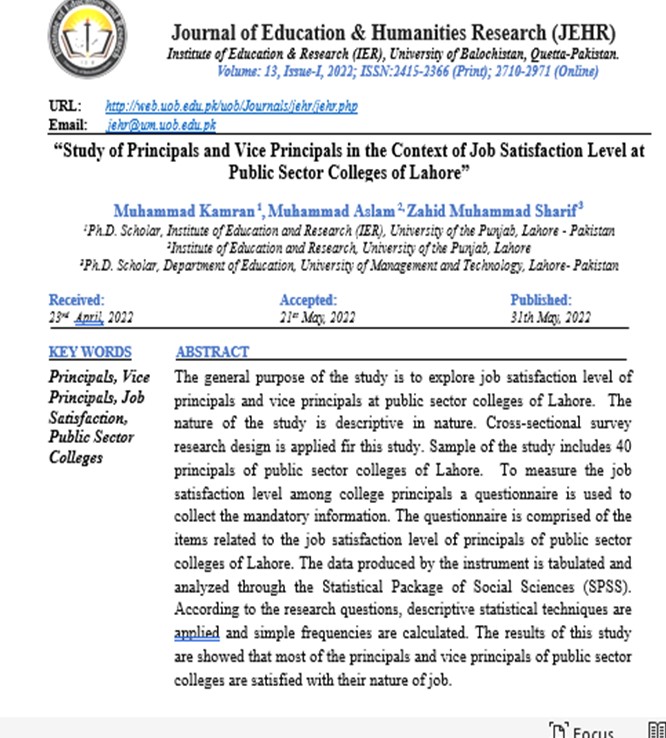Study of Principals and Vice Principals in the Context of Job Satisfaction Level at Public Sector Colleges of Lahore
Abstract
Abstract
The general purpose of the study is to explore job satisfaction level of principals and vice principals at public sector colleges of Lahore. The nature of the study is descriptive in nature. Cross-sectional survey research design is applied fir this study. Sample of the study includes 40 principals of public sector colleges of Lahore. To measure the job satisfaction level among college principals a questionnaire is used to collect the mandatory information. The questionnaire is comprised of the items related to the job satisfaction level of principals of public sector colleges of Lahore. The data produced by the instrument is tabulated and analyzed through the Statistical Package of Social Sciences (SPSS). According to the research questions, descriptive statistical techniques are applied and simple frequencies are calculated. The results of this study are showed that most of the principals and vice principals of public sector colleges are satisfied with their nature of job.
References
Brief, A. P., & Weiss, H. M. (2002). Organizational behavior: Affect in the workplace. Annual Review of Psychology, 53(1), 279-307.
Balzer, W. K., Kihm, J. A., Smith, P. C., Irwin, J. L., Bachiochi, P. D., Robie, C., et al. (2000). Users’ manual for the job descriptive index (JDI; 1997 version) and the job in general scales. In J. M. Stanton and C. D. Crossley (Eds.), Electronic resources for the JDI and JIG. Bowling Green, OH: Bowling Green State University.
Campbell, S. L., Fowles, E. R., & Weber, B. J. (2004). Organizational structure and job satisfaction in public health nursing. Public Health Nursing, 21(6), 564-571.
Fraser, J., & Hodge, M. (2000). Job Satisfaction in higher education: Examining gender in professional work settings. Sociology Inquiry, 70(2), 172-187.
Locke, E.A. (1976). The nature and causes of job satisfaction. In M. D. Dunnette (Ed.), Handbook of Industrial and Organizational Psychology (pp. 1297-1349). Chicago, IL: Rand McNally.
Kalleberg, A. L. (1977). Work values and job rewards: A theory of job satisfaction. American Sociological Review, 42(1), 124-143.
Porter, L.W., & Lawler, E. E. (1965). Properties of organizational structure in relation tonjob attitudes and job behavior. Psychological Bulletin, 64, 23-51.
Sellgren, S. F., Ekvall, G., & Tomson, G. (2008). Leadership behavior of nurse managers in relation to job satisfaction and work climate. Journal of Nursing Management, 16, 578-587.
Smerek, R., & Peterson, M. (2007). Examining herzberg’s theory: Improving job satisfaction among non-academic employees at a university. Research in Higher Education, 48(2), 229-250.
Talbert-Hersi, D. E. (1994). The impact of chronic job stressors and work support on job satisfaction for women in higher education: A communication climate study. Unpublished doctoral dissertation, Howard University.
Thomas, B. W. (1987). “Gender differences in job satisfaction of men and women Administrators in higher education. Unpublished doctoral dissertation, Michigan State University.
Van Saane, N. V., Sluiter, J. K., Verbeek, J. H. A. M. & Frings-Dresen, M. H. W. (2003). Occupational Medicine, 53(3), 191-200.
Volkwein, J. F., & Zhou, Y. (2003). Testing a model of administrative job satisfaction. Research in Higher Education, 44(3), 149-171.
Volkwein, J. F., & Parmley, K. (2000). Comparing administrative satisfaction in public and private universities. Research in Higher Education, 41(1), 95-116.
Vroom, V. H. (1964). Work and motivation. New York: Wiley.




